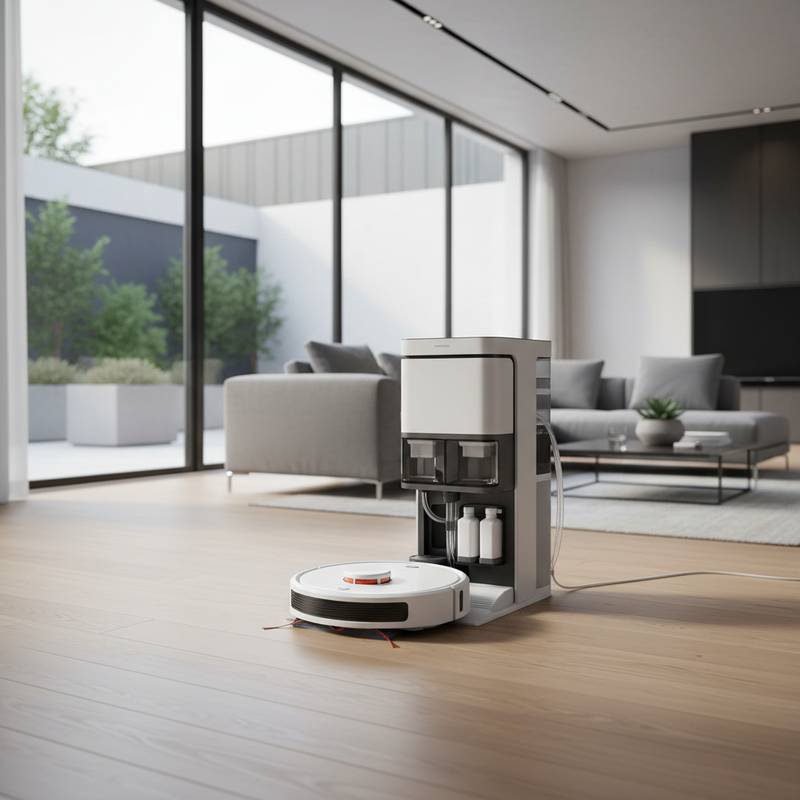Week-Long Mopping with Self-Refilling Robot Vacuums
Advancements in smart home technology have elevated floor cleaning far beyond basic navigation. Today's robot vacuums not only vacuum and mop but also self-empty dustbins and refill water tanks automatically. These self-refilling models support a full week of hands-free operation, offering unmatched convenience for households with demanding schedules.
Homeowners increasingly prioritize automation that minimizes daily tasks while ensuring pristine environments. Self-refilling robot vacuums align with this demand by integrating precise navigation and self-sustaining maintenance routines. The result is consistent floor cleanliness without frequent interruptions.
Limitations of Earlier Robot Mops
Initial robot mops introduced automated cleaning but required substantial user involvement. Owners needed to manually refill small water reservoirs, dispose of soiled water, and replace saturated mop pads after every session. This approach turned promised automation into a series of repetitive steps.
Premium models with combined vacuum-mop functions often exhausted their water supply after covering just a few areas. In expansive homes or high-traffic zones prone to spills, these devices fell short of providing comprehensive coverage. The core need remained for a system that operated independently over extended periods.
Innovations in Self-Refilling Technology
Self-refilling robot vacuums overcome these issues with sophisticated docking stations that automate fluid management. Upon returning to base, the robot connects to the station, which replenishes clean water and extracts dirty water while maintaining the mop components. This process enables daily cleaning cycles for seven days or longer with minimal oversight.
Picture docking the unit once at the start of the week; it then activates on schedule, detects soil levels, modulates water usage, and retreats to base as required. At week's end, simply discard accumulated waste from the station's reservoir. This setup delivers reliable results across various home layouts.
Technical Breakdown
These systems rely on engineered docking units featuring dual reservoirs for clean and waste water. During docking, valves open to transfer fresh water to the robot's internal tank and siphon out contaminants to the waste tank. Integrated sensors monitor levels to prevent overflows or shortages.
Advanced units incorporate pumps to rinse mop pads under pressure, followed by high-speed spinning or heated air circulation to eliminate moisture. Such features inhibit bacterial growth and odors, ensuring the pads remain hygienic for subsequent uses. Together, these elements form a closed-loop system for sustained performance.
Broader Implications for Home Care
Beyond ease of use, self-refilling robot vacuums advance eco-friendly practices. Precision sensors regulate water disbursement based on dirt detection, applying only what is essential per area. This targeted approach cuts water usage significantly when compared to traditional methods.
For daily life, the advantages are profound. Professionals reclaim hours previously spent on floors, while families with active pets or kids benefit from proactive dirt removal. Individuals facing physical limitations gain independence through accessible, low-effort hygiene solutions.
Leading Models in Action
Top manufacturers now offer integrated vacuum-mop robots paired with multifunctional docks. These stations handle dust evacuation, water cycling, and pad maintenance in one unit. Wi-Fi connectivity enables app-based oversight of fluid status, run logs, and alerts for periodic checks.
One notable device combines suction and mopping with LiDAR mapping for obstacle avoidance, sustaining a week's worth of sessions across multi-room homes. Feedback highlights its ability to adapt to layouts, navigating furniture and thresholds with accuracy.
A competing system allows customizable detergent mixing in the dock, tailoring solutions for hardwood, tile, or carpeted surfaces. These developments illustrate a progression toward robots that respond dynamically to specific cleaning demands.
Trends in Automated Home Ecosystems
Industry reports indicate surging demand for comprehensive cleaning automation. This mirrors expansions in connected devices, from voice-activated controls to synchronized appliances. Self-refilling vacuums slot into this framework, enhancing overall home intelligence.
Envision a coordinated setup where the robot aligns cleaning with occupancy patterns, perhaps triggering post-dinner runs via integration with other smart tools. Such synergy elevates routine maintenance to an intuitive, background process.
Addressing Adoption Challenges
Despite their strengths, these vacuums face hurdles in accessibility. Bulky docks demand adequate floor space, ideally near electrical outlets, and some require plumbing connections for optimal function. Compact living situations may necessitate creative placement strategies.
Upfront costs for feature-rich models remain elevated, though competitive pricing from new entrants is narrowing the gap. Savvy buyers weigh long-term savings in time and cleaning supplies against initial outlay. Scaling production promises further affordability in the near term.
Selection Criteria for Buyers
When evaluating self-refilling robot vacuums, consider these essential aspects:
- Station Capacity and Build: Opt for expansive tanks with robust seals to manage leaks and smells effectively.
- Pad Maintenance Features: Prioritize units that rinse, spin, and dry mops to uphold sanitation standards.
- Navigation Capabilities: Select models employing laser or visual mapping for thorough coverage and collision prevention.
- Mobile App Functionality: Ensure the interface supports scheduling, progress tracking, and proactive notifications.
- Operational Noise: Position noisier refill processes in less-trafficked zones to minimize disruptions.
Matching these to your space and habits yields optimal results.
Daily Experience with Advanced Cleaning
Integration brings swift improvements in floor upkeep. The robot maintains surfaces proactively, curbing dust accumulation and stains through regular passes. Owners frequently note the psychological relief of delegating this chore entirely.
As the device accumulates data on usage, it refines routes and resource allocation accordingly. High-traffic zones receive intensified attention, while quieter areas use less water. This evolution fosters progressively smarter, more tailored cleaning.
Achieving Sustainable Floor Maintenance
Self-refilling robot vacuums pave the way for low-intervention home care. They deliver enduring cleanliness that adapts to your routine, conserving resources while simplifying life. Invest in one to experience the shift toward truly autonomous living spaces.
